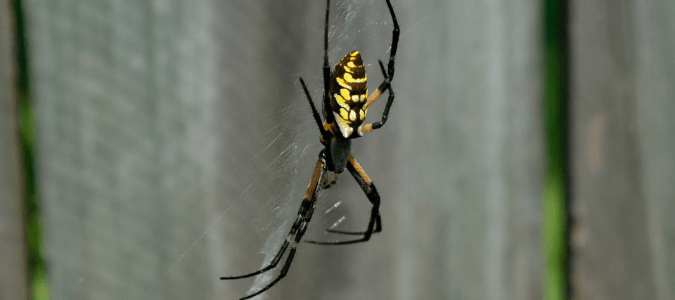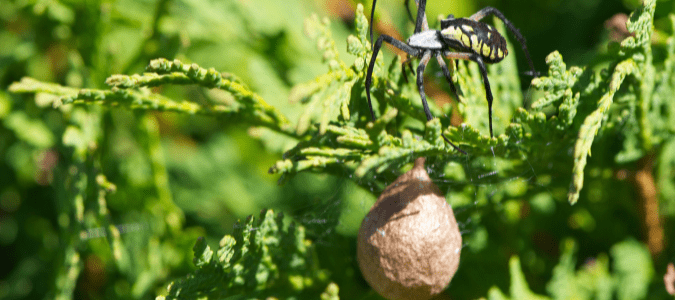If you’re out in the yard and you come across a big, black-and-yellow spider, chances are good that it’s a yellow garden spider. This is a very common species of arachnid that’s found across the country. But, their large size and striking appearance can make almost anyone’s heart rate speed up a little. As soon as you see one, your first question might be, is a yellow garden spider harmful or helpful?
The good news is, this spider rarely comes indoors. And, as long as you don’t pick it up and handle it, it’s very unlikely that it will bite you. Even if you are bitten by a yellow garden spider, its venom isn’t harmful to humans—but it is to other pests, including flies and mosquitoes. Since spiders help keep pest populations down, all this puts the yellow garden spider in the “helpful” category. Still, many people aren’t big spider fans—especially not spiders that are quite this big and scary-looking.
Identifying a Yellow Garden Spider
Yellow garden spiders are most often black and yellow, but they can also be black and white. They have long, black legs, sometimes with yellow or orange-colored sections or bands on them. The females of the species have much larger abdomens than the males. In fact, male yellow garden spiders’ bodies are very small and narrow, especially compared to their long legs. And, their bodies and legs are less brightly colored than those of the females. Female yellow garden spiders can have bodies that are up to an inch long, with abdomens almost a centimeter wide. No wonder so many people find them scary!
Another striking thing about yellow garden spiders is the webs they weave. These spiders usually spin their webs in sunny places outside where there are plenty of plants nearby that they can use to anchor their webs. Their web can be up to two feet wide, and they usually contain an interesting zigzag formation of thickly spun silk called a stabilimentum in the center. It looks a little like a zipper or a scribbled line of writing, which is why some people also call this a writing spider.
What Do Yellow Garden Spiders Eat?
Since yellow garden spiders eat lots of insects, including ones that most people consider to be annoying pests, they are actually considered beneficial in a yard or garden. These spiders eat mainly flying insects, like flies and wasps as well as bees, grasshoppers and dragonflies.
Yellow garden spiders usually wait in their webs head-down for an insect to fly into its web. When an insect flies (or leaps) into a yellow garden spider’s web, it gets stuck in the sticky fibers. The spider wraps the insect in more silk and then bites it to inject it with venom, which paralyzes the insect. The spider usually waits before eating its captured prey.
If you have lots of spiders in your yard or your home, it can be a sign that you have other pests lurking around as well. Spiders can’t live in places without a steady food supply. So, if you don’t like spiders, a big part of getting rid of them is getting rid of the pests that they feed on. Sometimes, the best way to do this is with professional help.
A pest control specialist can help you reduce spider populations around your property. They will start by making a thorough inspection of the area to determine what types of pests are present—not just spiders, but other insects and critters as well. That will let them know the best products and techniques to use to resolve not just the spider problem, but to control pest problems that you may not have realized were present.
How to Identify a Yellow Garden Spider Egg Sac
If you spot a yellow garden spider egg sac, you might not be sure exactly what you’re looking at. These spiders reproduce only once a year. They create large egg sacs that range from whitish to brownish-yellow in color, with a surface that looks like wrinkled paper. The egg sac may be even bigger than the full-grown female spider that created it! That is saying something, since yellow garden spiders are pretty large.
A yellow garden spider egg sac actually looks a lot like a paper pouch in the shape of a big teardrop, with a rounded bottom and a pinched top. The sac might be a half-inch across by three-quarters of an inch long. Yellow garden spiders secure their egg sacs in their webs, often in spots that are hidden from view, like under a large leaf. An egg sac might hold between 50 and 100 babies, which hatch in the fall but don’t come out of the sac until springtime.
A yellow garden spider mama will do whatever she can to protect her babies in their sac. So, if you come across one of these in your yard, try not to disturb it—the mama may bite you! Yellow garden spiders aren’t known for biting humans, and their bites aren’t harmful to us. Still, if you handle one of these spiders, it may bite you in self-defense or in defense of its babies. Some people say a yellow garden spider bite feels a lot like a bee sting—ouch! For this reason, it’s best to leave these spiders alone when you come across them.
It’s also a good idea to leave their egg sacs alone since these spiders are actually beneficial in a yard or garden. Even so, lots of people very understandably don’t want spiders lurking around. People especially don’t want big spiders like yellow garden spiders or wolf spiders taking up residence in their yard. If you have a spider problem in your yard or inside your house, it’s a good idea to contact a pest control professional to address the issue. Hiring a pro has lots of benefits. First and foremost, it’s the quickest and most efficient way to deal with a pest infestation. And, best of all, you don’t have to come into contact with the spiders yourself.
How to Prevent Spiders from Infesting Your Home and Yard
Learning how to prevent spiders from infesting your house and yard is an important part of general pest control around your property. Spiders are natural predators of other pests, including flies, mosquitoes, ants and even roaches. Unfortunately, we can’t rely on spiders to make much of a dent in an actual pest infestation. But, staying on top of controlling and preventing other pest infestations will go a long way toward controlling spider populations as well. This is good news for anyone who hates spiders!
There are many steps you can take on your own to make your home and property less attractive to spiders. One important step is to address other pest infestation issues you may have. Roaches, flies and other food sources attract spiders. So, if you have a lot of spiders in your house, it’s likely you have other pests, too. Signing up for ongoing pest management with a reputable company can go a long way toward getting rid of spiders. They can make your property less appealing to these creatures by reducing populations of other common pests.
Here are other steps you can take to cut down on the number of spiders you have in and around your home:
- Clear away any piles of underbrush or debris from your property, like old boards, dead branches or other items. These items might attract spiders looking for a good place to hide and spin a web. These steps can also help prevent grass spiders.
- Trim bushes and other landscaping where spiders might live away from the outside of your home. This way, spiders can’t get inside as easily.
- If possible, plan your yard and garden beds so most plants are away from the home instead of near its exterior walls.
- Fix any gaps or tears in and around your windows, doors and screens. This way, spiders can’t get inside through the holes and apply weather-stripping around exterior doors.
- Look for any holes and gaps on the exterior of your home that need sealing with caulk or covering with wire mesh to keep critters out. You might find these around the eaves or around vents, hose bibs or pipes.
Again, most people find that the biggest factor in getting rid of spiders is getting rid of the insects they’re feeding on. This can be achieved through maintaining your house and property in ways that reduce insect populations in and around your home. You’ll have faster and better results if you combine do-it-yourself efforts like the ones described above with professional pest treatments. Professionals have the experience and tools needed to deal with spiders and other pests. That way, you’ll be able to have peace of mind knowing you can spend time in your yard or your house without encountering creepy crawlies at every turn.
ABC Can Make Your Property Less Appealing to Spiders and Pests
Even if there is some benefit to having spiders around, running into one can make you feel uneasy. If you want to reduce your likelihood of running into these creatures, contact ABC Home & Commercial Services. Our pros can identify the spiders you’re dealing with, especially the tricky ones like brown recluses and wolf spiders. Then, we can create a pest control plan that makes your yard less appealing to common pests as well as spiders, so you can feel more comfortable in your home and yard.



